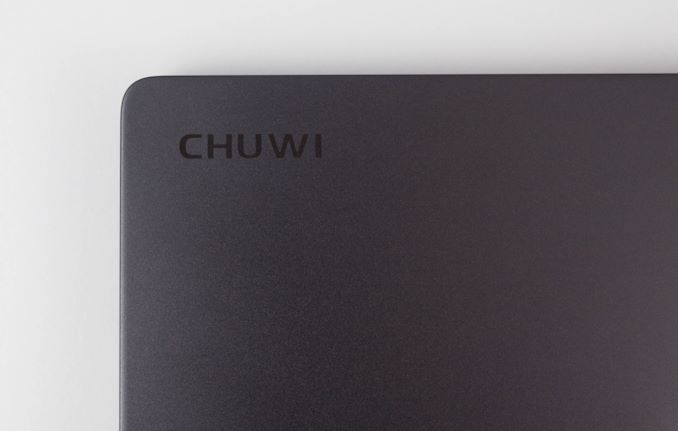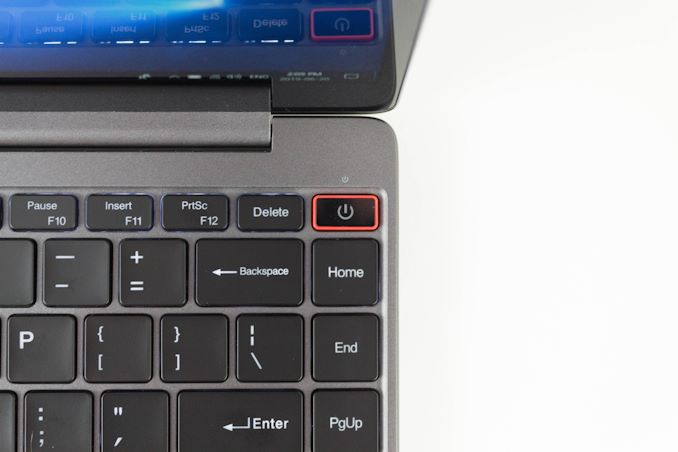The Chuwi AeroBook Review: One Small Step For Chuwi
by Brett Howse on June 21, 2019 8:00 AM ESTFinal Words
Chuwi took a bit of a gamble moving from the Atom platform they were comfortable with, to Intel’s Y series of Core processors, and overall, it is a gamble that has paid off well. Even the Skylake-era Core m3-6Y30 found in the AeroBook offers a noticeable improvement in performance compared to the previous LapBooks we have tested from the manufacturer, which featured Atom-based processors. The GPU gets an especially large bump, moving from 12 Execution Units on Atom, to 24 on Core, and although the GPU is still anemic for gaming tasks, the extra performance is still welcome.
Chuwi has mimicked the MacBook with their design, and it’s hard to fault them on the execution. The aluminum exterior offers a premium feel, even though some of the notebook is still plastic. Chuwi also offers a modern slim-bezel design, which shrinks the 13.3-inch notebook and makes it even more portable. They’ve done that while keeping the webcam in the correct location though, so it’s nicely achieved.
The laptop is very light, coming in at 1.26 kg / 2.77 lbs, and coupled with the thin design and small bezels, makes the AeroBook very easy to take with you. When you consider the price, it’s very impressive that they’ve designed such a great looking device while still keeping it thin and light.
Not all was done well though. The display, while continuing to be a 1920x1080 IPS panel like they offer on some of their other notebooks, is well off the mark in terms of color accuracy. Its only real saving grace is that it is able to achieve the sRGB gamut, but that’s a low bar. A similarly priced Surface Go from Microsoft comes with an individually calibrated display. Coupled with the poor accuracy is mediocre contrast. The 1920x1080 IPS is appreciated, but also expected in this price range; and other than the resolution and wide viewing angles, the rest of the display is sub-par.
Chuwi has often struggled with battery life, which could be somewhat attributed to smaller battery capacities to hit their price target. That is certainly the case here again, with just a 38 Wh battery when the typical 13.3-inch Ultrabook has closer to 50 Wh or more. Furthermore, Chuwi has not done any real work on the platform power draw, and the Chuwi AeroBook has some of the highest idle power draw of any notebook in its class, so when coupled with a smaller than average battery, overall battery life is well off the mark.
There are other areas where Chuwi has saved money, but they aren’t as big of an impact. The 1x1 wireless solution is there as a cost-savings measure, but they’ve at least gone with the Intel Wireless adapter, meaning it’s slow, but rock solid. Chuwi has also opted for a slower SATA SSD, but considering most of the competition in this price range would still offer a spinning drive, or eMMC storage, the 256 GB SSD is most certainly welcome. Chuwi also makes it incredibly easy to replace the SSD with a dedicated cover on the bottom of the laptop for easy access. The single-channel RAM is also a cost-saving measure, but at least there’s a solid 8 GB of memory, meaning this laptop isn’t going to run out of RAM on most light tasks.
There’s no doubt that the AeroBook is an improvement over some of the other Chuwi models, while still keeping a great design, but, and this is always the key, Chuwi has to be especially careful when their price creeps up, because they are no longer competing against poor machines. But they’ve continued to offer the value-add bonues compared to their competition. The AeroBook would be something I would compare against the original ASUS Core M laptop – the UX305 – where they offer enough RAM and storage to make this device usable, but keep the price down. The AeroBook doesn’t quite hit the same level of fit and finish of the ASUS Zenbook, but offers similar performance and specifications at hundreds of dollars less.
If you need great battery life, this Chuwi AeroBook is not for you. But for a general purpose laptop, it offers a great design, reasonable performance, and as much RAM and SSD storage as machines that cost quite a bit more. So when you factor that in, the $499 MSRP is still rather attractive. If Chuwi is going to continue to try and compete in higher brackets, they will need to address some of their faults, but at the $500 range, the Chuwi AeroBook still offers a lot for the price.













51 Comments
View All Comments
Mil0 - Sunday, June 23, 2019 - link
Ah, this article mentions that it wakes up when sleeping, but not when hibernated: https://www.zdnet.com/article/windows-10-tip-keep-...ArcadeEngineer - Friday, June 21, 2019 - link
I have had hibernated laptops wake up for windows updates before, it seems to be a quite new 'feature'.Rookierookie - Sunday, June 23, 2019 - link
They do a good job of waking you up in the middle of the night.zodiacfml - Saturday, June 22, 2019 - link
Windows update 1903 wakes my laptop from sleep. First time in the life of that 2015 laptopcfenton - Saturday, June 22, 2019 - link
"After a bit of howling and screaming they did offer me to send it to HongKong for a free replacement, and I am torn between using it just on external power or actually see if it gets back fixed."That right there should be a huge red flag for anyone considering Chuwi. If they're selling it in North America, then there should be somewhere I can send it for repair in North America. If they don't want to do that, then they should be cross-shipping (for free) at the very least.
Spunjji - Wednesday, June 26, 2019 - link
Even with weird / intense usage, it should take a *lot* longer than a year for a battery to swell like that. It was definitely a manufacturing fault.StormyParis - Friday, June 21, 2019 - link
Can you keep using it ? I've had huge durability issues with 3rd-tier Chinese OEMs (Teclast and Chuwi esp., Cube has been OK for me) and according to fellow complainers (a highly representative sample /s) on Techtablets' youtube channel, I'm not alone.They've managed to make stuff that's OK out of the box (it wasn't, a few years ago). Now it seems the things are still fragile, especially with iffy connectors and batteries.
I've had no issues whatsoever with 10+ XIaomi devices, and since they're barely more expensive than Teclast Chuwi et al., I'm sticking with Xiaomi for now.
DanNeely - Friday, June 21, 2019 - link
My Teclast T8 tablet's still in good shape after 15 months; but I went with a lower tier Chinese maker because I don't use my tablet much and didn't want to pay apple/samsung prices; but wanted something with a higher DPI display than Amazon's race to the bottom Kindles.I managed to keep my 8" Dell android tablet for about 4 years; despite the model I got being cursed with a highly fragile usb port so I'm not overly concerned about general breakableness.
OFelix - Friday, June 21, 2019 - link
There's a good chance I would buy this laptop apart from 1 thing:I do NOT buy laptops with glossy screens !!
eastcoast_pete - Friday, June 21, 2019 - link
Looks nice enough. The main no-go for me is the low battery life. Also, how long do Chuwi's keyboards and track pads last?